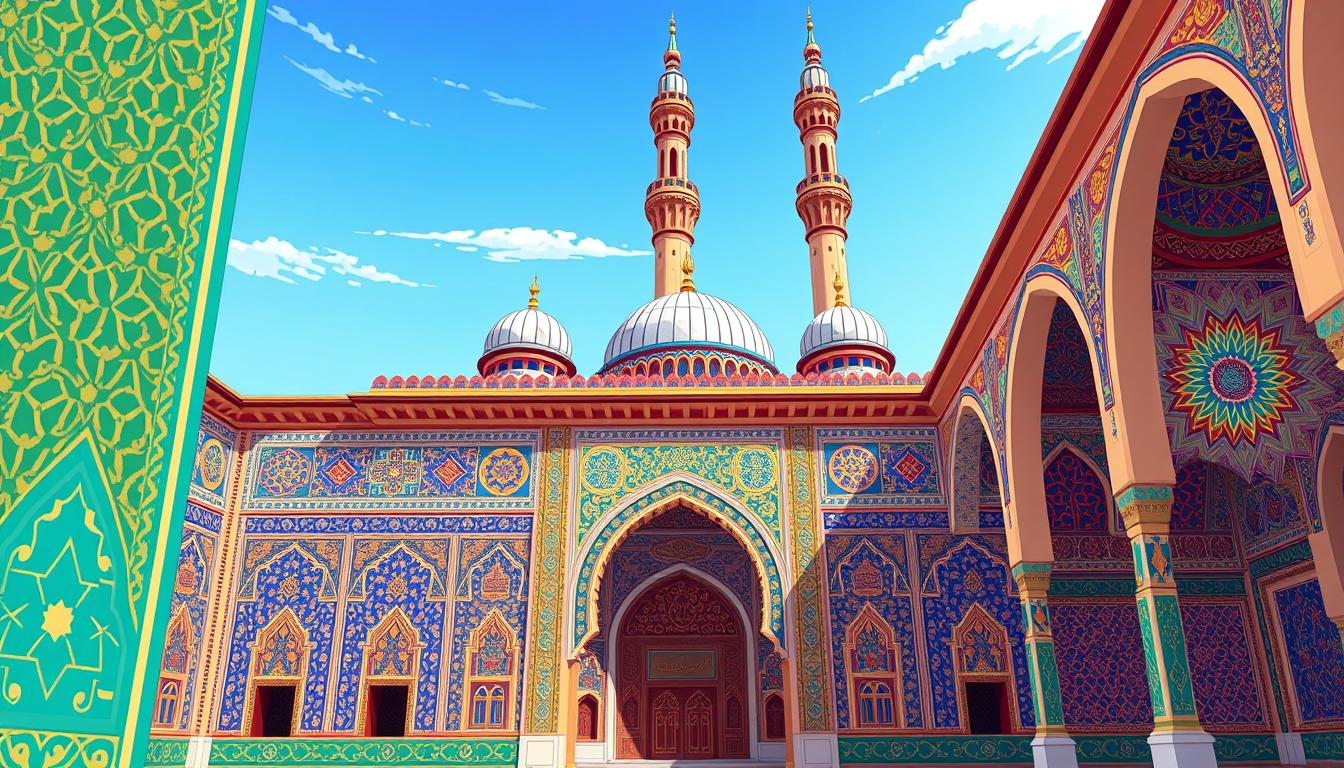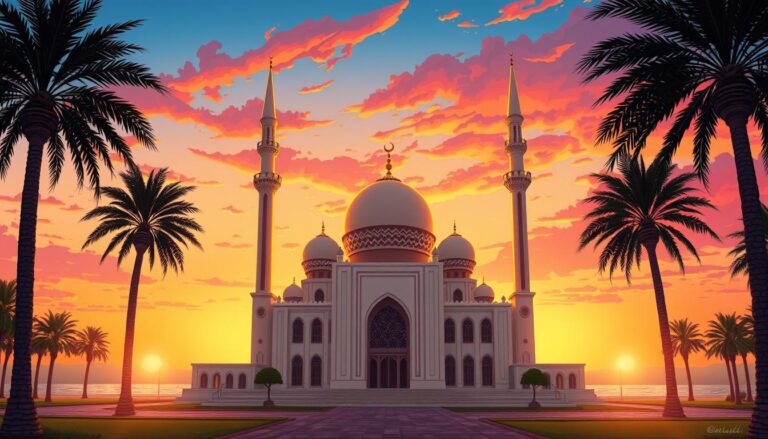Islam in Oman
Islam is the main religion in Oman, brought in by the Prophet Muhammad in the early 7th century. Muhammad named Amr ibn al-As as the first governor. He stayed until Muhammad passed away in 632 CE.
Amr and Sa’id ibn Aws al-Ansari went to the Al-Julanda brothers, Oman’s rulers, to invite them to Islam. This peaceful start marked the beginning of Islamic history Oman.
Now, 85.9% of Oman’s people are Muslim. About 45% are Sunni Islam followers, and 45% are Ibadi Islam followers. The remaining 5% are Shia Muslims.
Omani Sharia law and Omani religious practices deeply influence the country. They shape everything from Omani mosques to Oman Ramadan celebrations.
Oman’s love for Islam in Oman has enriched its Muslim traditions Oman. It has created a unique and lively Islamic art Oman. This art attracts visitors from all over the world.
Introduction to Islam in Oman
Oman welcomed Islam in the early 7th century. This was thanks to Prophet Muhammad’s teachings. At first, Oman followed Sunni Islam, guided by Amr ibn al-As.
But, the Ibaadi branch of the Khawarij movement found a home in Oman. They fled Basra in modern-day Iraq.
Oman’s Embrace of Islam
The first Ibaadi state in Oman started in 750 CE. It came after the Umayyed Caliphate fell. But, the Abbasid Caliphate took over in 752 CE.
Another Ibadi state began in 793 CE. It lasted until the Abbasids took it back in 893 CE. Over time, Ibadism became a big part of Omani life. This led to the return of Ibadi imamates in the late modern era.
The Significance of Ibadhi Islam
Ibadism, named after Abdallah ibn Ibad, a major Khawarij leader, started after the Battle of Siffin in 657 CE. The Ibadis arrived in Oman around 700 CE. They were part of the Kharijite group but later took a more moderate stance.
This sect has greatly influenced Oman’s Islamic history. It has shaped the country’s religious and cultural scene for centuries.
“Oman is known for practicing a peaceful form of Islam that encourages dialogue and understanding.”
Historical Roots of Islam in Oman
Oman welcomed Islam in the early 7th century CE. Prophet Muhammad appointed Amr ibn al-As as Oman’s governor. He stayed until Muhammad’s death in 632 CE. Amr and Sa’id ibn Aws al-Ansari were sent to the Al-Julanda brothers to invite them to Islam.
The Prophet’s Letter and Early Conversion
This mission started Islam’s growth in Oman. The Al-Julanda brothers and their people accepted Islam. This shows Oman’s openness to the Prophet’s message and Islam’s smooth blend into local culture.
The Emergence of Ibadism
- The Ibāḍī branch of the Khawarij emerged in Oman after fleeing Basra in modern-day Iraq.
- The first Ibāḍī state was formed in Oman in 750 CE. It lasted until the Abbasid Caliphate took over in 752 CE.
- In 793 CE, another Ibāḍī state was established. It lasted until the Abbasids recaptured it in 893 CE.
The Ibāḍī denomination is now the main sect of Islam in Oman. It makes up about 90% of the Muslim population.
“Oman’s early conversion to Prophet Muhammad’s message and the subsequent establishment of Ibadism have deeply shaped the country’s religious and cultural identity.”
Denominations of Islam in Oman
Oman is known for its rich Islamic heritage. It has a mix of Islamic denominations. About 85.9% of Oman’s people are Muslim, with most being Sunni or Ibadhi.
Sunni Muslims make up about 45% of Oman’s population. Ibadhi Muslims also account for 45%. The remaining 5% are Shia Muslims.
Oman is special because it brings together different Islamic traditions. The Ibadhi sect has a big presence here, with its own beliefs and history.
Most Omanis are Sunni or Ibadhi Muslims. But, there’s also a small Shia Muslim community. These groups add to Oman’s rich culture and social life, promoting tolerance and understanding.
Oman values its religious diversity. It has laws that protect different Muslim and non-Muslim groups. Yet, the government also controls religious activities to keep peace and stability.
“Oman’s religious landscape reflects its unique history and role as a bridge between the Islamic world and other civilizations.”
Oman is changing, and so is its mix of Islamic denominations and government policies. This will shape the country’s future in many ways.
Sunni Islam in Oman
About 45% of Oman’s Muslims follow Sunni Islam. Sunni communities are mainly found south of the Al-Hajar mountains and along some coasts. These areas have kept their Sunni traditions since Amr ibn al-As’s time.
In Oman, Sunni Islam has different schools of thought. The Shafi’i school is big in Al Wusta & Dhofar’s south. Meanwhile, the Hanbali school is more common in the north.
“The government does not publish statistics on the percentages of citizens who practice Ibadhi, Sunni, and Shia Islam.”
It’s estimated that Sunni Muslims are almost 50% of Oman’s citizens. The rest are mostly Ibadhi Muslims at 45%. Shia Muslims, Hindus, and Christians make up the last 5%.
Oman also has many noncitizen religious groups. These include Hindus, Buddhists, Sikhs, Baha’is, and Christians. They are a big part of the country’s expat population.
Even though Ibadhi Islam is seen as Oman’s state religion, the government supports a “generic” Islam. This is to unite Ibadi and Sunni Muslims. It helps avoid conflicts and keeps the society together.
Ibadism: The Predominant Sect
Ibadism comes from Abdallah ibn Ibad, who started it. It began after the Battle of Siffin in 657 CE. The Ibadis arrived in Oman around 700 CE. They were part of the Kharijite group but later took a more moderate stance.
Origins and Establishment in Oman
By 750 CE, the Ibadis had their first state in Oman. But it was short-lived and fell to the Abbasid Caliphate in 752 CE. Despite this, the Ibadis grew by forming alliances with local tribes. Today, they are the majority in Oman.
The Ibadi Imamate System
The Ibadis set up imamate systems where the imam had both religious and political power. Over time, Ibadism became deeply rooted in Omani society. However, the Ibadi imamate faced challenges in the mid-20th century. This led to the Jebel Akhdar War (1954-1959), where the Sultanate of Muscat, with British help, fought the Ibadi imamate.
“Ibāḍīs make up the majority of the population in Oman, and Ibāḍīsm is a moderate Khārijite group that emphasizes an elected imam over a hereditary one.”
- The Ibāḍī imamate arrived in Oman in the mid-8th century, unifying the country politically.
- Ibāḍīs converted leading tribal clans to their sect in Oman.
- The Ibāḍīyah, the Ibāḍī sect, founded the Rustamid kingdom in opposition to the ʿAbbāsid dynasty.
Islam in Oman
Ibadi Reforms under the Sultanate
The Sultanate of Oman started in the mid-18th century. It changed from the Ibadi imamate system to a hereditary monarchy. This change came from internal conflicts and help from the British.
Ahmed bin Hamad al-Khalili, the Ibadi’s Grand Mufti, led these reforms. His efforts have shaped today’s Ibadi practice in Oman.
Al-Khalili supported the hereditary monarchy. This move was away from choosing imams based on merit and piety. It was part of efforts to modernize the state and fit Ibadism into a modern nation.
The Ibadhi reforms in Oman have been key in the Oman Sultanate‘s growth. They have also influenced the Ibadhi leadership changes over time.
“The conflict between the Ibadis and the Sultanate ended with the defeat of the Ibadi imamate during the Jebel Akhdar War (1954-1959).”
Even though they were not the majority, the Ibadis became the ruling sect in Oman. They were able to organize and mobilize local tribes. But, the Ibadi imamate lost during the Jebel Akhdar War.
This loss led to the Sultanate’s reforms. It also helped integrate Ibadism into the modern Omani state.
Differences from Mainstream Islam
Oman is mostly Ibadhi Muslim, but Ibadism is different from Sunni Islam. Ibadis don’t follow the Sunni way of choosing leaders. They believe in picking imams based on their good deeds and faith.
Ibadis don’t agree with Sunni leaders being chosen by family. They think leaders should be chosen by talking and deciding together. But, Oman’s Ibadhi leaders now follow a system where leaders pass down their power to family members.
Theological Foundations
Ibadis are a small group, making up only one percent of Muslims. Oman has the most Ibadis in the world. Many Sunnis see Ibadis as a “deviant sect,” especially in Saudi Arabia.
Ibadis pray differently and see Islam in their own way compared to Sunnis. The Omani government tries to make Islam seem the same for everyone. They want to bring Ibadis and Sunnis together, showing Oman’s wish for peace and unity.
“Ibadis have historical ties to the early Kharijite movement, which believed the Imam should be chosen from the community through consultation, rather than by hereditary succession.”
Islamic Art and Architecture in Oman
Oman’s rich Islamic heritage is seen in its mosques. These buildings show the country’s unique architectural styles. They are both ancient and modern, serving as community centers and reflecting Islam’s impact on Omani culture.
The Islamic art and architecture in Oman show the country’s strong faith connection. With over 13,600 mosques, Oman’s landscape is filled with these sacred buildings. They mix old and new styles.
The Sultan Qaboos Grand Mosque in Muscat is a key example. Finished in 2001, it has unique domes and minarets inspired by nature. Modern mosques in Oman also blend different styles, especially in big cities.
Arabic calligraphy is a big part of Omani mosques. It shows the Islamic faith through art. The design of these mosques highlights minarets and domes. Minarets call people to prayer, and domes let in natural light, creating a peaceful space.
Mosques in Oman are more than places of worship. They are community centers for prayer, learning, and culture. They promote unity and show the inclusive nature of Islamic art and architecture in Oman.
“The architecture of mosques in Oman is a fusion of traditional and modern elements, creating a unique and captivating visual experience for visitors.”
The history of Islamic architecture in Oman goes back to the early Islamic era. It has been influenced by many cultures, like Roman, Byzantine, Iranian, and Mesopotamian. The evolution of Islamic art and architecture in Oman shows the country’s deep faith connection. Mosques are a source of pride and cultural identity for Omanis.
Conclusion
Islam has deeply shaped Oman’s culture, traditions, and daily life. The country follows Ibadhi Islam, a moderate branch of Kharijism. This has been a key part of Oman’s religious identity for centuries.
Despite challenges and reforms, Ibadism remains a big part of Omani society. It helps make the country unique and inspires a strong respect for Islamic heritage.
Oman’s Ibadhi Islam shows a lot of tolerance towards other faiths. This, along with the government’s rules on public religious practices, creates a peaceful environment. Here, diversity is valued within the Islamic framework.
As Oman faces the modern world’s challenges, Islam’s lasting impact on its culture and identity is clear. It has played a crucial role in shaping the country. From the stunning Sultan Qaboos Grand Mosque to the warm Omani hospitality, Islam’s influence is everywhere.
Oman is a great example of how a nation can mix its religious heritage with today’s needs. It shows that it’s possible to keep traditions alive while moving forward.
Source Links
- Islam in Oman
- Ibadi Islam
- Learn about Islam in Muscat, Oman! – New Brunswick Theological Seminary
- Religious freedom – www.fm.gov.om
- Oman – Early History, Geography, People
- LibGuides: Ibadi Islam: History
- Religion in Oman
- Oman – United States Department of State
- Oman – United States Department of State
- Oman Culture : Language, Religion, Food
- Sultanate and Imamate in Oman – ICWA
- The Essentials of Ibadi Islam
- Ibāḍīyyah | Islamic sect
- U of T conference on Ibadism highlights pluralism within Islamic tradition
- Oman – United States Department of State
- Oman: A Beacon of Tolerance in the MENA Region | Geopolitical Monitor
- Islam in Oman – Wikiwand
- Briefing European Parliamentary Research Service
- A tapestry of divine aesthetics and cultural heritage in the Sultanate
- Islamic architecture
- Evaluating the Resonance of Official Islam in Oman, Jordan, and Morocco
- Cultural Connections: Islam’s Beauty in Omani Life







